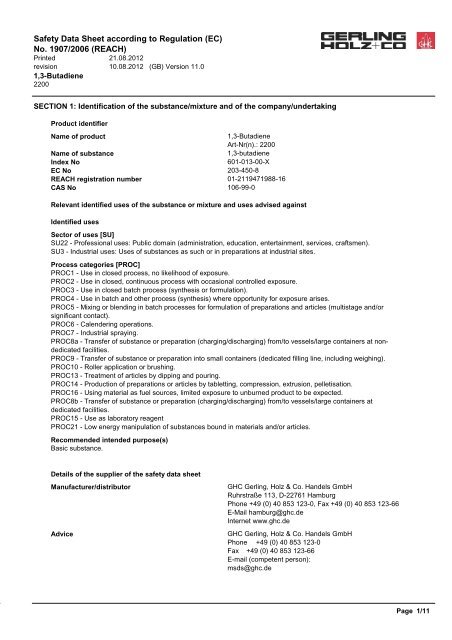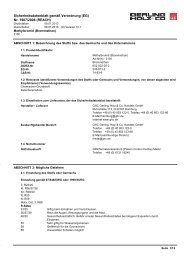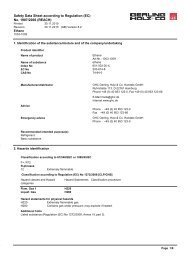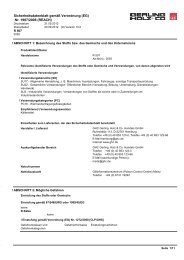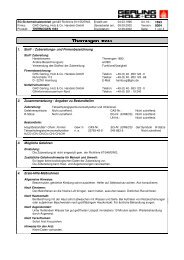material safety data sheet - GHC Gerling, Holz + Co. Handels GmbH
material safety data sheet - GHC Gerling, Holz + Co. Handels GmbH
material safety data sheet - GHC Gerling, Holz + Co. Handels GmbH
You also want an ePaper? Increase the reach of your titles
YUMPU automatically turns print PDFs into web optimized ePapers that Google loves.
Safety Data Sheet according to Regulation (EC)<br />
No. 1907/2006 (REACH)<br />
Printed 21.08.2012<br />
revision 10.08.2012 (GB) Version 11.0<br />
1,3-Butadiene<br />
2200<br />
SECTION 1: Identification of the substance/mixture and of the company/undertaking<br />
Product identifier<br />
Name of product 1,3-Butadiene<br />
Art-Nr(n).: 2200<br />
Name of substance 1,3-butadiene<br />
Index No 601-013-00-X<br />
EC No 203-450-8<br />
REACH registration number 01-2119471988-16<br />
CAS No 106-99-0<br />
Relevant identified uses of the substance or mixture and uses advised against<br />
Identified uses<br />
Sector of uses [SU]<br />
SU22 - Professional uses: Public domain (administration, education, entertainment, services, craftsmen).<br />
SU3 - Industrial uses: Uses of substances as such or in preparations at industrial sites.<br />
Process categories [PROC]<br />
PROC1 - Use in closed process, no likelihood of exposure.<br />
PROC2 - Use in closed, continuous process with occasional controlled exposure.<br />
PROC3 - Use in closed batch process (synthesis or formulation).<br />
PROC4 - Use in batch and other process (synthesis) where opportunity for exposure arises.<br />
PROC5 - Mixing or blending in batch processes for formulation of preparations and articles (multistage and/or<br />
significant contact).<br />
PROC6 - Calendering operations.<br />
PROC7 - Industrial spraying.<br />
PROC8a - Transfer of substance or preparation (charging/discharging) from/to vessels/large containers at nondedicated<br />
facilities.<br />
PROC9 - Transfer of substance or preparation into small containers (dedicated filling line, including weighing).<br />
PROC10 - Roller application or brushing.<br />
PROC13 - Treatment of articles by dipping and pouring.<br />
PROC14 - Production of preparations or articles by tabletting, compression, extrusion, pelletisation.<br />
PROC16 - Using <strong>material</strong> as fuel sources, limited exposure to unburned product to be expected.<br />
PROC8b - Transfer of substance or preparation (charging/discharging) from/to vessels/large containers at<br />
dedicated facilities.<br />
PROC15 - Use as laboratory reagent<br />
PROC21 - Low energy manipulation of substances bound in <strong>material</strong>s and/or articles.<br />
Recommended intended purpose(s)<br />
Basic substance.<br />
Details of the supplier of the <strong>safety</strong> <strong>data</strong> <strong>sheet</strong><br />
Manufacturer/distributor <strong>GHC</strong> <strong>Gerling</strong>, <strong>Holz</strong> & <strong>Co</strong>. <strong>Handels</strong> <strong>GmbH</strong><br />
Ruhrstraße 113, D-22761 Hamburg<br />
Phone +49 (0) 40 853 123-0, Fax +49 (0) 40 853 123-66<br />
E-Mail hamburg@ghc.de<br />
Internet www.ghc.de<br />
Advice <strong>GHC</strong> <strong>Gerling</strong>, <strong>Holz</strong> & <strong>Co</strong>. <strong>Handels</strong> <strong>GmbH</strong><br />
Phone +49 (0) 40 853 123-0<br />
Fax +49 (0) 40 853 123-66<br />
E-mail (competent person):<br />
msds@ghc.de<br />
Page 1/11
Safety Data Sheet according to Regulation (EC)<br />
No. 1907/2006 (REACH)<br />
Printed 21.08.2012<br />
revision 10.08.2012 (GB) Version 11.0<br />
1,3-Butadiene<br />
2200<br />
Emergency telephone number<br />
Emergency advice Giftinformationszentrum (Poison <strong>Co</strong>ntrol Centre) Mainz<br />
Phone +49 (0) 6131 19240<br />
SECTION 2: Hazards identification<br />
Classification of the substance or mixture<br />
Classification according to 67/548/EEC or 1999/45/EC<br />
F+; R12<br />
Carc. Cat. 1; R45<br />
Muta. Cat. 2; R46<br />
R-phrases<br />
45 May cause cancer.<br />
46 May cause heritable genetic damage.<br />
12 Extremely flammable.<br />
Classification according to Regulation (EC) No 1272/2008 [CLP/GHS]<br />
Hazard classes and Hazard<br />
categories<br />
Flam. Gas 1 H220<br />
Liquef. Gas H280<br />
Muta. 1B H340<br />
Carc. 1A H350<br />
Hazard Statements Classification procedure<br />
Hazard statements for physical hazards<br />
H220 Extremely flammable gas.<br />
H280 <strong>Co</strong>ntains gas under pressure; may explode if heated.<br />
Hazard statements for health hazards<br />
H340 May cause genetic defects.<br />
H350 May cause cancer.<br />
Label elements<br />
Labelling according to Regulation (EC) No 1272/2008 [CLP/GHS]<br />
GHS02 GHS04 GHS08<br />
Signal word<br />
Danger<br />
Hazard statements for physical hazards<br />
H220 Extremely flammable gas.<br />
H280 <strong>Co</strong>ntains gas under pressure; may explode if heated.<br />
Hazard statements for health hazards<br />
H340 May cause genetic defects.<br />
H350 May cause cancer.<br />
Page 2/11
Safety Data Sheet according to Regulation (EC)<br />
No. 1907/2006 (REACH)<br />
Printed 21.08.2012<br />
revision 10.08.2012 (GB) Version 11.0<br />
1,3-Butadiene<br />
2200<br />
Precautionary Statements<br />
Prevention<br />
P202 Do not handle until all <strong>safety</strong> precautions have been read and understood.<br />
P210 Keep away from heat/sparks/open flames/hot surfaces. – No smoking.<br />
P280 Wear protective gloves/protective clothing/eye protection/face protection.<br />
Response<br />
P308 + P313 IF exposed or concerned: Get medical advice/attention.<br />
P377 Leaking gas fire: Do not extinguish, unless leak can be stopped safely.<br />
P381 Eliminate all ignition sources if safe to do so.<br />
Storage<br />
P403 Store in a well-ventilated place.<br />
P405 Store locked up.<br />
Hazardous ingredients for labeling<br />
1,3-butadiene<br />
Special rules for supplemental label elements for certain mixtures<br />
Restricted to professional users.<br />
Other hazards<br />
Information pertaining to special dangers for human and environment<br />
In high concentrations may cause asphyxiation.<br />
Gas/vapour heavier than air. May accumulate in confined spaces, particularly at or below ground level.<br />
<strong>Co</strong>ntact with liquid may cause cold burns/frostbite.<br />
SECTION 3: <strong>Co</strong>mposition/ information on ingredients<br />
Substances<br />
CAS No 106-99-0 1,3-butadiene<br />
EC No 203-450-8<br />
Index No 601-013-00-X<br />
REACH registration number 01-2119471988-16<br />
Additional advice<br />
Stabiliser: =< 0.5 % weight 4-tert-butylpyrocatechol, CAS No 98-29-3, EC No 202-653-9.<br />
SECTION 4: First aid measures<br />
Description of first aid measures<br />
General information<br />
Remove contaminated soaked clothing immediately and dispose it safely.<br />
Adhere to personal protective measures when giving first aid.<br />
In case of inhalation<br />
Remove the casualty into fresh air and keep him immobile.<br />
Seek medical treatment immediately.<br />
In case of respiratory standstill give artifical respiration by respiratory bag (Ambu bag) or respirator. Send for a doctor.<br />
In case of skin contact<br />
In case of contact with skin wash off with soap and water.<br />
In case of frostbite rinse with plenty of water. Don`t remove clothing.<br />
In case of frostbite spray with lukewarm (not hot) water for at least 15 minutes. Apply a sterile dressing. Obtain<br />
medical assistance.<br />
Page 3/11
Safety Data Sheet according to Regulation (EC)<br />
No. 1907/2006 (REACH)<br />
Printed 21.08.2012<br />
revision 10.08.2012 (GB) Version 11.0<br />
1,3-Butadiene<br />
2200<br />
In case of eye contact<br />
Rinse cautiously with water for several minuts. Remove contact lenses, if present and easy to do. <strong>Co</strong>ntinue rinsing.<br />
Call for a doctor immediately.<br />
In case of ingestion<br />
Ingestion is not considered a potential route of exposure.<br />
Most important symptoms and effects, both acute and delayed<br />
Physician's information / possible symptoms<br />
The following symptoms may occur in case of strong exposition:<br />
Disorientation<br />
Unconsciousness<br />
Headache<br />
<strong>Co</strong>nfusion<br />
Dizziness<br />
Indication of any immediate medical attention and special treatment needed<br />
Treatment (Advice to doctor)<br />
Treat symptoms.<br />
Monitor circulation.<br />
SECTION 5: Firefighting measures<br />
Extinguishing media<br />
Suitable extinguishing media<br />
Foam<br />
Dry powder<br />
Carbon dioxide<br />
Water spray jet<br />
Extinguishing media which must not be used for <strong>safety</strong> reasons<br />
Full water jet<br />
Special hazards arising from the substance or mixture<br />
In case of fire formation of dangerous gases possible.<br />
Formation of explosive gas mixtures in air.<br />
In the event of fire the following can be released:<br />
Carbon monoxide (CO)<br />
Advice for firefighters<br />
Special protective equipment for fire-fighters<br />
Use breathing apparatus with independent air supply ( isolated ).<br />
Wear full protective clothing.<br />
Additional information<br />
<strong>Co</strong>ol endangered containers with water spray jet.<br />
Exposure to fire may cause containers to rupture / explode.<br />
Do not extinguish a leaking gas flame unless absolutely necessary. Spontaneous/explosive re-ignition may occur.<br />
Extinguish any other fire.<br />
<strong>Co</strong>llect contaminated firefighting water separately, must not be discharged into the drains.<br />
Page 4/11
Safety Data Sheet according to Regulation (EC)<br />
No. 1907/2006 (REACH)<br />
Printed 21.08.2012<br />
revision 10.08.2012 (GB) Version 11.0<br />
1,3-Butadiene<br />
2200<br />
SECTION 6: Accidental release measures<br />
Personal precautions, protective equipment and emergency procedures<br />
Remove persons to <strong>safety</strong>.<br />
Evacuate area.<br />
Eliminate all ignition sources if safe to do so.<br />
Keep away sources of ignition.<br />
Environmental precautions<br />
If possible, stop flow of product.<br />
Eliminate ignition sources.<br />
Do not discharge into the drains/surface waters/groundwater.<br />
Suppress gases/vapours/mists with water spray jet<br />
Do not discharge into the subsoil/soil.<br />
Methods and <strong>material</strong> for containment and cleaning up<br />
Ensure adequate air ventilation.<br />
Reference to other sections<br />
Informations for safe handling see chapter 7.<br />
Informations for personal protective equipment see chapter 8.<br />
SECTION 7: Handling and storage<br />
Precautions for safe handling<br />
Advice on safe handling<br />
Use only in thoroughly ventilated areas.<br />
Transfer and handle only in enclosed systems.<br />
Barrels and installations thoroughly earthing (grounding ).<br />
Use antistatic tools.<br />
Treatment only in suitable rooms and systems.<br />
Provide good room ventilation even at ground level (vapours are heavier than air).<br />
Prevent cylinders from falling over.<br />
Ensure valve protection device is correctly fitted.<br />
Ensure valve outlet cap nut or plug (where provided) is correctly fitted.<br />
Open valve slowly to avoid pressure shock.<br />
Do not allow backfeed into the container.<br />
No water to valves, flanges and other fittings.<br />
Purging of pipes and valves with inert gases - to avoid: water, solvents.<br />
Advice on protection against fire and explosion<br />
The product is combustible.<br />
Because of risk of explosion avoid vapours getting into cellar, sewage system and holes.<br />
Take precautionary measures against static discharges.<br />
Formation of explosive gas mixtures in air.<br />
Use explosion-proof equipment / fittings and non-sparking tools.<br />
<strong>Co</strong>nditions for safe storage, including any incompatibilities<br />
Requirements for storage rooms and vessels<br />
Keep in closed original container.<br />
Ventilate store-rooms thoroughly.<br />
Use transportable pressure equipment.<br />
Suitable <strong>material</strong>s: Normalised steel and carbon steel, tempered steel, aluminium alloys, stainless steel.<br />
Valve: Suitable <strong>material</strong>s: Brass, copper alloys, carbon steels, aluminium alloys, stainless steel.<br />
Advice on storage compatibility<br />
Do not store together with combustible liquids or combustible solids.<br />
Do not store together with animal feedstuffs.<br />
Do not store together with explosives.<br />
Do not store together with infectious substances.<br />
Page 5/11
Safety Data Sheet according to Regulation (EC)<br />
No. 1907/2006 (REACH)<br />
Printed 21.08.2012<br />
revision 10.08.2012 (GB) Version 11.0<br />
1,3-Butadiene<br />
2200<br />
Do not store together with radioactive <strong>material</strong>.<br />
Do not store together with toxic liquids or toxic solids.<br />
Do not store together with food.<br />
Do not store together with oxidizing agents.<br />
Further information on storage conditions<br />
Ensure valve protection device is correctly fitted.<br />
Keep container tightly closed and store at cool and aired place.<br />
Prevent cylinders from falling over.<br />
Protect of heat.<br />
Storage temperature may not exceed 50°C (=122°F).<br />
Specific end use(s)<br />
Recommendation(s) for intended use<br />
See exposure scenario(s).<br />
SECTION 8: Exposure controls/personal protection<br />
<strong>Co</strong>ntrol parameters<br />
Ingredients with occupational exposure limits to be monitored<br />
CAS No Name <strong>Co</strong>de [mg/m3] [ppm] Remark<br />
106-99-0 Buta-1,3-diene WEL, 8 hours 22 10 HSE EH40/<br />
2005<br />
106-99-0 Buta-1,3-diene 8 hours 0,19 USA - NIOSH<br />
106-99-0 Buta-1,3-diene 8 hours 1<br />
USA - OSHA<br />
Short-term 15<br />
Additional advice<br />
DNEL (workers, inhalation, long-term, systemic effects): 2,21 mg/m³ (1,0 ppm).<br />
Exposure controls<br />
Respiratory protection<br />
Keep self contained breathing apparatus readily available for emergency use.<br />
In case of rescue and maintenance activities in storage containers use environment-independent breathing<br />
apparatus because of risk of suffocation by edging out of air oxygen<br />
Short-term: filter apparatus, filter AX, otherwise environment-independent breathing apparatus.<br />
Hand protection<br />
Leather gloves<br />
In case of increased risk: Glove <strong>material</strong> specification [make/type, thickness, permeation time/life]: NBR; >= 0,4 mm;<br />
> 480 min.<br />
Eye protection<br />
<strong>safety</strong> goggles, in case of increased risk add protective face shield<br />
Skin protection<br />
Safety shoes with steel toe.<br />
Body covering work clothing, or chemical resistant suit at increased risk.<br />
General protective measures<br />
Do not inhale gases/vapours/aerosols.<br />
Hygiene measures<br />
At work do not eat, drink and smoke.<br />
Limitation and surveillance of the environment<br />
PNEC: not required, because the substance is gaseous.<br />
See chapter 7.<br />
Page 6/11
Safety Data Sheet according to Regulation (EC)<br />
No. 1907/2006 (REACH)<br />
Printed 21.08.2012<br />
revision 10.08.2012 (GB) Version 11.0<br />
1,3-Butadiene<br />
2200<br />
SECTION 9: Physical and chemical properties<br />
Information on basic physical and chemical properties<br />
Form<br />
Gaseous / liquefied under pressure.<br />
<strong>Co</strong>lour<br />
colourless<br />
Important health, <strong>safety</strong> and environmental information<br />
pH value in delivery state not<br />
applicable<br />
Odour<br />
aromatic<br />
Value Temperature at Method Remark<br />
boiling point -4,41 °C 1013 hPa<br />
melting point -108,9 °C<br />
Flash point -85 °C<br />
Ignition temperature 415 °C DIN 51794<br />
Lower explosion limit 1,4 Vol-%<br />
Upper explosion limit 16,3 Vol-%<br />
Vapour pressure 2351 hPa 20 °C<br />
Density 631 kg/m3 285 K information<br />
concerns to<br />
liquid phase<br />
Rel. vapour density 1,92<br />
Solubility in water 0,5 g/l 20 °C<br />
Solubility/other soluble in<br />
organic solvent<br />
Partition coefficient (log<br />
pOW)<br />
1,99 25 °C pH 7<br />
Viscosity dynamic 0,149 mPa*s 20 °C information<br />
concerns to<br />
liquid phase<br />
Viscosit dynamic 0,117 mPa*s 315 K information<br />
concerns to<br />
liquid phase<br />
Oxidizing properties<br />
no<br />
Explosive properties<br />
Due to its structure the product is not classified as explosive.<br />
Page 7/11
Safety Data Sheet according to Regulation (EC)<br />
No. 1907/2006 (REACH)<br />
Printed 21.08.2012<br />
revision 10.08.2012 (GB) Version 11.0<br />
1,3-Butadiene<br />
2200<br />
Other information<br />
Vapours are heavier than air.<br />
SECTION 10: Stability and reactivity<br />
Reactivity<br />
See section "Possibility of hazardous reactions".<br />
Chemical stability<br />
Stable under normal conditions.<br />
Stabil mittels Stabilisator.<br />
Possibility of hazardous reactions<br />
May react violently with oxidants.<br />
Risk of polymerisation.<br />
Formation of peroxides possible (in the presence of light and atmospheric oxygen).<br />
<strong>Co</strong>nditions to avoid<br />
Formations of peroxides possible.<br />
Formation of explosive gas/air mixtures.<br />
Heat sources / heat - risk of bursting.<br />
Incompatible <strong>material</strong>s<br />
Materials to avoid<br />
Strong oxidizing agents.<br />
Hazardous decomposition products<br />
When handled and stored appropriately, no dangerous decomposition products are known.<br />
Thermal decomposition<br />
Remark No decomposition if used as directed.<br />
Additional information<br />
Unstable product may polymerize spontaneously.<br />
! SECTION 11: Toxicological information<br />
Information on toxicological effects<br />
Acute toxicity/Irritability/Sensitization<br />
Value/Validation Species Method Remark<br />
LD50 acute oral 5480 mg/kg rat<br />
LC50 acute<br />
inhalation<br />
Irritability skin not applicable<br />
Irritability eye not applicable<br />
Skin sensitization not applicable<br />
Sensitization<br />
respiratory system<br />
285 mg/l (4 h) rat<br />
not determined<br />
Page 8/11
Safety Data Sheet according to Regulation (EC)<br />
No. 1907/2006 (REACH)<br />
Printed 21.08.2012<br />
revision 10.08.2012 (GB) Version 11.0<br />
1,3-Butadiene<br />
2200<br />
Subacute Toxicity - Carcinogenicity<br />
Value Species Method Validation<br />
Subchronic Toxicity NOAEL 2,212 mg/l (5 d) Rat (male / female) OECD - 6 h/d<br />
Inhalation<br />
Mutagenicity Information on genotoxicity in<br />
vivo and in vitro available.<br />
Reproduction-<br />
Toxicity<br />
No indications of toxic<br />
effects were observed in<br />
reproduction studies in<br />
animals.<br />
Carcinogenicity Indications of carcinogenic<br />
effects are available from<br />
long-term trials.<br />
! Toxicity test (Additional information)<br />
In animal studies cancerogenic effects proved.<br />
! Experiences made from practice<br />
May cause cancer.<br />
May cause frostbite.<br />
Gases have a suffocating effect.<br />
Inhalation causes narcotic effect/intoxication.<br />
Additional information<br />
The product is a substance of Carc. Cat. 1<br />
The product is a substance of Muta. Cat. 2.<br />
! SECTION 12: Ecological information<br />
Toxicity<br />
Ecotoxicological effects<br />
Value Species Method Validation<br />
Fish LC50 45 mg/l (96 h) Pimephales<br />
promelas<br />
Daphnia EC50 33 mg/l (48 h) Daphnia magna Calculated<br />
Algae EC50 33 mg/l (72 h) Calculated, cell<br />
reproduction<br />
Bacteria not determined<br />
Calculated Not acutely harmful to<br />
aquatic organisms.<br />
Persistence and degradability<br />
Physico-chemical not determined<br />
degradability<br />
The product is highly volatile and can be largely eliminated from the water by stripping.<br />
Biological<br />
degradability<br />
not determined<br />
The product is not readily biodegradable to OECD criteria but is inherently biodegradable.<br />
Page 9/11
Safety Data Sheet according to Regulation (EC)<br />
No. 1907/2006 (REACH)<br />
Printed 21.08.2012<br />
revision 10.08.2012 (GB) Version 11.0<br />
1,3-Butadiene<br />
2200<br />
Degradability not determined<br />
Biological<br />
eliminability<br />
Elimination rate Method of analysis Method Validation<br />
The product is highly volatile and can be largely eliminated from the water by stripping.<br />
not determined<br />
At normal temperature very highly volatile or gaseous product that can be released to atmosphere.<br />
Elimination test cannot be employed.<br />
Bioaccumulative potential<br />
Because of the n-octanol/water distribution coefficient (log K o/w) accumulation in organisms is not expected.<br />
Mobility in soil<br />
not applicable<br />
Results of PBT and vPvB assessment<br />
This substance does not meet the PBT/vPvB criteria of REACH, annex XIII.<br />
Other adverse effects<br />
! Behaviour in sewage plant<br />
not determined<br />
Additional ecological information<br />
Value Method Remark<br />
COD not determined<br />
! SECTION 13: Disposal considerations<br />
Waste treatment methods<br />
Waste code No. Name of waste<br />
16 05 04* gases in pressure containers (including halons) containing dangerous substances<br />
Wastes marked with an asterisk are considered to be hazardous waste pursuant to Directive 91/689/EEC on hazardous<br />
waste.<br />
! Recommendations for the product<br />
Dispose of as hazardous waste.<br />
Incinerate in suitable incineration plant, but care for official regulations.<br />
Recommendations for packaging<br />
Transportable pressure equipment (empty, residual pressure): Return to supplier / manufacturer.<br />
SECTION 14: Transport information<br />
Land and inland navigation transport ADR/RID<br />
UN 1010 BUTADIENES, STABILIZED (1,3-butadiene), 2.1, (B/D), Classification code: 2F<br />
Marine transport IMDG<br />
UN 1010 BUTADIENES, STABILIZED (1,3-butadiene), 2.1<br />
Air transport ICAO/IATA-DGR<br />
UN 1010 Butadienes, stabilized (1,3-butadiene), 2.1<br />
Special precautions for user<br />
The protective measures listed in Sections 6, 7 and 8 of the Safety Data Sheet have to be considered.<br />
Transport in bulk according to Annex II of MARPOL 73/78 and the IBC <strong>Co</strong>de<br />
No transport as bulk according IBC - <strong>Co</strong>de.<br />
Page 10/11
Safety Data Sheet according to Regulation (EC)<br />
No. 1907/2006 (REACH)<br />
Printed 21.08.2012<br />
revision 10.08.2012 (GB) Version 11.0<br />
1,3-Butadiene<br />
2200<br />
SECTION 15: Regulatory information<br />
Safety, health and environmental regulations/legislation specific for the substance or mixture<br />
Other regulations (EU)<br />
Regulation (EC) No 1907/2006 concerning the Registration, Evaluation, Authorisation and Restriction of Chemicals<br />
(REACH), Annex XVII No 28 - 30.<br />
Regulation (EC) No 1907/2006 concerning the Registration, Evaluation, Authorisation and Restriction of Chemicals<br />
(REACH), Annex XVII No 40.<br />
Directive 96/82/EC on the control of major-accident hazards involving dangerous substances.<br />
VOC standard<br />
VOC content >=99,5 % 20 °C 2351 hPa<br />
Chemical Safety Assessment<br />
For this substance a chemical <strong>safety</strong> assessment has been carried out.<br />
Exposure scenarios (ESs) see http://www.ghc.de/pdf_e/es2200.001e.pdf.<br />
! SECTION 16: Other information<br />
Recommended uses and restrictions<br />
National and local regulations concerning chemicals shall be observed.<br />
! Further information<br />
All declarations of <strong>safety</strong>-<strong>data</strong>-<strong>sheet</strong> refer to pure substance.<br />
The information contained herein is based on the state of our knowledge. It characterizes the product with regard to<br />
the appropriate <strong>safety</strong> precautions. It does not represent a guarantee of the properties of the product.<br />
Indication of changes: "!" = Data changed compared with the previous version.<br />
Wording of the R/H-phrases specified in chapter 3 (not the classification of the mixture!)<br />
R 12 Extremely flammable.<br />
R 45 May cause cancer.<br />
R 46 May cause heritable genetic damage.<br />
H220 Extremely flammable gas.<br />
H280 <strong>Co</strong>ntains gas under pressure; may explode if heated.<br />
H340 May cause genetic defects (state route of exposure if it is conclusively proven that no other routes of exposure<br />
cause the hazard).<br />
H350 May cause cancer (state route of exposure if it is conclusively proven that no other routes of exposure cause the<br />
hazard).<br />
Page 11/11


